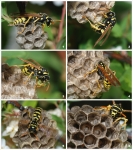Getting Rid Of These Pests
Allergic reactions to stings, can develop anywhere on the body and can range from non-life-threatening reactions, such as hives, swelling, nausea, vomiting, abdominal cramps, and headaches to life-threatening reactions, such as anaphylactic shock, unconsciousness, difficulty breathing, and blockage of the airway.
Anaphylaxis is a severe allergic reaction to a bee or wasp sting that affects a limited portion of the population (one or two out of every 1,000 people). For these people, being stung by a bee or a wasp may be life threatening.
While fewer than 100 fatal reactions to sting venom are reported annually in the U.S., it is imperative that if it’s suspected that someone is allergic to sting venom, they be examined by a medical provider.
A medical provider may prescribe either a “sting kit” which includes epinephrine (adrenaline) loaded in a hypodermic syringe for injection, or an Epi-Pen which is an auto-injector loaded with epinephrine.
The best time of the year to control wasps is in June after the queen has established her colony and while the colony is still small. The first step in bees and wasp control is to correctly identify the insect and locate its nesting site.
Getting rid of these pests can sometimes be fearful, especially if you are allergic. A large nest may mean an attack and stings on you or other people in the area. Hiring a professional pest control can mean safe and efficient handling of the wasps and bees. Pest control experts are trained in handling these stinging pests and we can rid your home or business quickly using nontoxic organic products.
Read Full Post »





